Written by Beth Brown, GWCT PARTRIDGE Project placement student
They chitter and they chatter, they are a busy little bird we call the house sparrow. House sparrows are a species close to many people’s hearts and homes, typically thought of as a garden bird, but can be found in urban and rural areas.
Being brown and grey, these little birds are often referred to as a ‘little brown job’ – the males have grey crowns, white cheeks and a black bib whilst the females are a plain buffy-brown all over with dingy grey-brown underparts. House sparrows feed and breed near people and are a colony species accrediting them their ‘busy’ characteristic, which explains the clusters of sparrows you’ll see fluttering around your hedgerows.
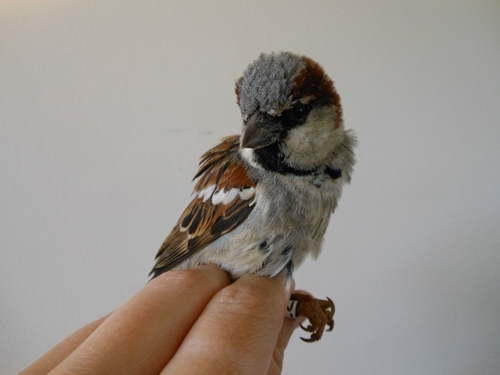 A male house sparrow being colour ringed, under appropriate BTO licensing.
A male house sparrow being colour ringed, under appropriate BTO licensing.
Last Sunday, the GWCT’s Head of Wildlife Recovery Dr Francis Buner held a talk about house sparrows in the church at Newton Valence in Hampshire. The talk provided lots of information about the house sparrow and gathered interest for a house sparrow box project, hoping to implement 50+ house sparrow boxes around the small rural village. The project aims to increase the local house sparrow population and also to allow us to study their population dynamics more closely.
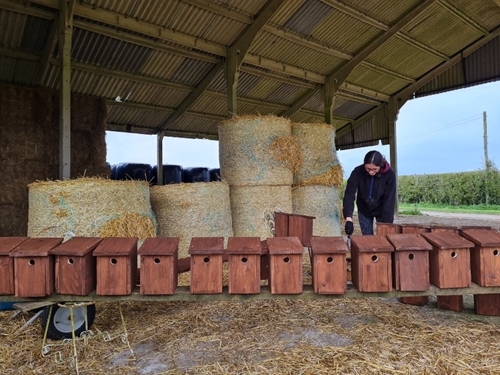 Beth Brown (GWCT placement student) constructing and
Beth Brown (GWCT placement student) constructing and
painting 50 Perdix house sparrow boxes for the project!
Upon arrival, people were greeted with the iconic house sparrow chatter echoing through the church, the source being our well-hidden speaker. This was followed by a background of the natural history of the house sparrow and the bird’s widespread influence. The influence of the house sparrow spread much further than our gardens, from literature to culture to poetry and to much more.
Most of us are well versed with the strong relationship between nature and literature, art, and music and how without nature the latter would struggle to exist. Francis read an assortment of sparrow poems and even treated us with a (spoken) hymn from the vicar’s post – certainly not a scientist’s natural environment – providing many chuckles from the audience, starting the talk nicely.
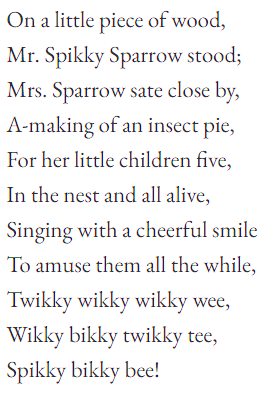 One of the poems Francis read, Mr and Mrs Spikky Sparrow, by Edward Lear.
One of the poems Francis read, Mr and Mrs Spikky Sparrow, by Edward Lear.
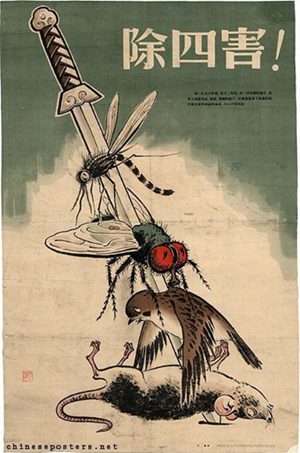 Francis then went on mentioning how humans have learnt a lot from sparrows. His example being the Great Chinese Famine in the late 50s, when the Great Leader Mao Tse-Tung decided to get rid of seed-eating sparrows to increase grain for human food.
Francis then went on mentioning how humans have learnt a lot from sparrows. His example being the Great Chinese Famine in the late 50s, when the Great Leader Mao Tse-Tung decided to get rid of seed-eating sparrows to increase grain for human food.
One way this was achieved was by banging metal pots and pans at the little birds whenever they attempted to land, tiring them out so much that they eventually dropped dead on the ground. Little did the typically naive humans know, these house sparrows eat a large number of insects when feeding their young, apart from grain during the rest of the year.
As you have probably predicted, this mass killing of the house sparrows caused locust populations to balloon, destroying crops and only exacerbating the famine. This is just one of the many tales that we hear and consider ourselves much wiser, but in reality, modern-day society and the humans that inhabit it have put more species at risk than ever before.
Although today in Britain we are not actively knocking the house sparrow from our skies, their drastic decline has been aided by human activity, with the main causes being changes in house construction, which has led to a reduction in nesting sites, together with the intensification of agricultural practices and changes in urban garden designs, both of which reduced insect and seed food availability.
One person in the audience commented on house sparrows being ‘misunderstood,’ partly because they are still one of the most regularly seen garden birds. Therefore, the public often, mistakenly, think our house sparrows are doing quite well. Sadly, this is not the case, with this year’s RSPB Big Garden Birdwatch finding that a startling 22 million house sparrows have disappeared from the UK since 1966.
Urgent action is needed if we are to continue hearing the joyful chitter chatter that we take for granted and associate with our gardens. One member of the audience said, ‘we will only notice them when they are no longer there’, only emphasising the need to protect this red-listed species.
During this talk I was lucky enough to carry out a short survey looking at what house sparrows meant to the local audience and why they wanted to conserve the house sparrow. I gathered 20 surveys and also had interest for further in-depth interviews to dig deeper into people's motives to carry out garden-scale conservation.
The survey also highlighted the success of the meeting with 19 respondents out of 20 stating they would implement a house sparrow box in their garden. With increasing urbanisation as more houses are built for the growing population, garden-scale conservation is becoming more important than ever before.
As a social scientist, studying Human Geography, the ‘people side’ of conservation is my special area of interest. Both social science and natural science are equally important when trying to reverse the decline of biodiversity. With the reasons of the decline being human caused, the focus of our management strategies must also be human centred.
It is important to understand how we engage the public and what motivates people to engage in conservation activities. It is also important to understand that most humans are not altruistic, so to motivate most humans there must be something in it for them. So, we must emphasise the joy that nature and wildlife bring us, we must appreciate our planet and we must help the younger generation to build strong lifelong connections with nature.
I thought one survey summarised the need to build a connection with nature in order to conserve it very nicely; when I asked why they would be willing to put a house box up in their garden, their response was ‘for the sparrow and me.’
The house sparrow is a quintessential member of British gardens and farmland. I was therefore curious to know what the house sparrow means to people who gave up some of their Sunday afternoon to learn more about them. The word cloud below summarises their responses. These responses seem very uplifting and give me much hope for the future of conservation.
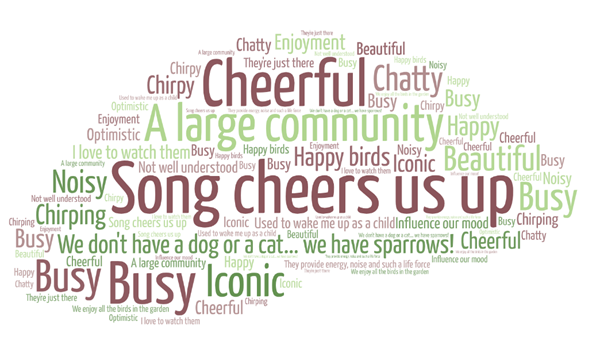
Tell us what the house sparrow means to you by writing down your phrase using this link. Thank you!